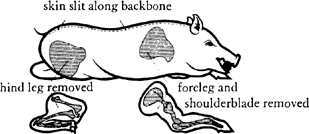Mastering the Art of French Cooking, Volume 2 (102 page)
Read Mastering the Art of French Cooking, Volume 2 Online
Authors: Julia Child

Baste in 20 minutes. Twenty minutes later, after pig has roasted a little more than an hour in all, baste again, and strew the onions, carrots, and garlic cloves in the pan. Continue basting every 20 minutes or so, using fat in pan when oil is used up; basting helps the skin to crisp and brown nicely. In a total of 2½ to 3 hours, meat thermometer should have reached 180 to 185 degrees, the thigh meat should be tender when pressed, the legs should move in their sockets, and the pig is done. (Note that a chilled, stuffed pig may take up to 30 minutes longer to roast, as may a 14-pound pig.)
Pig must now rest 30 minutes before carving, so that meat juices will retreat back into tissues. Turn oven off and leave door ajar, letting pig remain warm.
(*)
AHEAD-OF-TIME NOTE
: Pig can wait a good hour before carving; when oven has cooled for 20 minutes, reset thermostat to 140 degrees and close the door (or reheat oven briefly every 10 minutes).
6)
The sauce
The serving platter, tray, or board
2 cups veal stock or beef stock, or beef bouillon
1 cup dry port, Sercial Madeira, dry white wine, or dry white French vermouth
1 Tb dry mustard blended with 2 Tb of the stock or wine
A strainer set over a bowl or a saucepan
Salt and pepper
A warm sauce bowl
Lift pig, and drain its juices back into the roasting pan; set it on platter, remove foil, skewers, string, etc., and pluck end of tail from its hiding place. Remove rack, tilt pan, and spoon fat off roasting juices. Pour the stock or bouillon into the pan, and the wine; beat in the mustard mixture, and bring to the simmer, scraping coagulated roasting juices into liquid. Simmer slowly for 10 to 15 minutes while pig is being carved. (You may wish to scrape all of this liquid into a saucepan rather than simmering in the roasting pan.) When you are ready to serve, pour accumulated
carving juices into sauce, and strain sauce into bowl or pan, pressing juices out of vegetables. Skim off any surface fat, carefully correct seasoning, and pour sauce into warm bowl for serving.
7)
Decorations and presentation
Decorate the platter with leaves, and flowers or fruit, placing a garland of flowers around the pig’s neck, if you wish. Stick flowers in the eyes, and replace the ball of foil in its mouth with a shining red apple or a tangerine. (Orange blossoms, shiny green leaves, and yellow zinnias, for instance, are very attractive; at Christmastime, holly, cranberries, and white daisies would be appropriate.) Bring the pig to the table or parade it around the room, so that everyone may enjoy its splendor. Although you may carve at the table, we suggest the seclusion of the kitchen unless an expert in suckling pigs is among the party.
8)
Carving and serving
Provide yourself with 1 or 2 very sharp carving knives, a carving or kitchen fork, a big spoon, and a large pair of kitchen shears or poultry shears; an electric carving knife can be helpful in making the first cuts in the skin. We suggest you carve and serve one side, and return to the kitchen to carve the second side of the pig. Arrange it attractively again for the second serving at the table.
First, slit the skin the length of the backbone, using an electric carving knife if you have one. Then cut around skin where you feel the outline of the shoulder; lift off shoulder and foreleg portion. Do the same for the hind leg. Divide both into serving pieces, and set aside. |
|
| This drawing illustrates what you will find when you take your knife and cut down along the backbone and ribs to remove flesh and skin. Most of the meat is against the upper part of the ribs, and at the loin (from rump to ribs). |
Between meat and skin will be a layer of fat, more or less of it according to the age and size of the pig. Remove meat from fat, and carve meat into serving portions. Scrape fat from skin, and cut skin into serving strips about 1 inch wide and 3 to 4 inches long. (Shears would be useful here.)
Pull out the exposed rib bones, which will come loose easily. Spread part of stuffing out from cavity of pig, arrange the meat over the stuffing, and cover with strips of skin. If you have chosen brussels sprouts, broccoli, or other decorative vegetables, arrange them attractively around the meat. Redecorate platter with leaves and flowers as necessary, and serve the pig along with its sauce. (The other side of the pig will stay warm for second servings because the skin holds in the heat.)
BEEF, VEAL, PORK, AND LAMB TONGUES
Langues de Boeuf, de Veau, de Porc, et de Mouton
A beautiful beef tongue braising in aromatic sauce smells so good while it is cooking, looks so splendid when you bring it to the table, and makes such a welcome change from the usual fare in main-course dishes that you need have no hesitation at all in serving it for company. Half the price of beef, tongue is all solid meat and therefore something well worth adding to your culinary repertoire. Because beef tongue has the best flavor and texture, we shall concentrate on that; pork, veal, and lamb tongues, which are treated in the same general way, are taken up at the
end of this section
.




